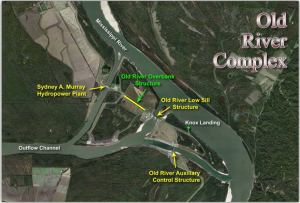Last updated on July 8th, 2021 at 01:38 pm
Some projects undergo budget depletion exercises after budget cuts. Or the exercises might occur when there’s evidence that the funds remaining won’t cover the work remaining. Formats vary, but the typical goal of these exercises is downscoping. We remove, relax, defer, or suspend some requirements. With limited funds, we execute downscoping in a manner that leads to technical debt.
A physical example

The industrial facilities of the lower Mississippi constitute a technical debt. Their existence is no longer compatible with the “update” Nature is trying to deploy. But our national budget won’t support repositioning New Orleans and its industrial facilities. So we redirect the flow of water from Nature’s course to one more compatible with the industrial base. The Old River Control Complex, with levees, dredging projects, and gates throughout lower Louisiana, are the MICs we pay for the technical debt that is the outdated position of New Orleans and its industrial base. For more about Atchafalaya, see the famous New Yorker article by John McPhee [MacFee 1987].
A broad array of effects
Here’s an illustrative scenario. At the time downscoping begins, the work product might contain incomplete implementations of items that are due for removal from the list of objectives. This removal renders unnecessary a set of accommodations contained in surviving artifacts. They comprise a most insidious type of debt that’s difficult to detect. It’s difficult to detect because the affected system components appear to be merely overly complicated. Recognizing them as a residual of a cancelled capability requires knowledge of their history. Unless we document these artifacts at the time of the downscoping, that knowledge may be lost.
Other items of technical debt that arise from budget depletion include tests that no longer serve a purpose, or documentation that’s no longer consistent with the rest of the work product, or user interface artifacts no longer needed. When budgets become sufficiently tight, funds aren’t available for documenting these items of technical debt as debt. The enterprise might then lose track of them when team members move on to other work.
Sometimes, budget depletion takes effect even before the work begins. This happens, for example, when project champions unwittingly underestimate costs to gain approval for the work they have in mind. The unreasonableness of the budget becomes clear soon after the budget approval, and its effects take hold soon thereafter.
Budget depletion can also have some of the same effects as schedule pressure. When the team devises the downscoping plan, it must make choices about what to include in the revised project objectives. In some cases, the desire to include some work can bias estimates of the effort required to execute it. If the team underestimates the work involved, the result is increased pressure to perform that work. With increased pressure comes technical debt. See “With all deliberate urgency” for more.
Last words
A policy that could limit technical debt formation in response to budget depletion would require identifying the technical debt such action creates, and later retiring that debt. Because these actions do require resources, they consume some of the savings that were supposed to accrue from downscoping. In some cases, they could consume that amount in its entirety, or more. Most decision makers probably over-estimate the effectiveness of the downscoping strategy. Often, it simply reduces current expenses by trading them for increased technical debt, which raises future expenses and decreases opportunities in future periods.
References
[MacFee 1987] John MacFee. “Atchafalaya,” The New Yorker, February 23, 1987.
Available: here; Retrieved: February 5, 2018.
Other posts in this thread
- Nontechnical precursors of nonstrategic technical debt
- Failure to communicate long-term business strategy
- Failure to communicate the technical debt concept
- Technological communication risk
- Team composition volatility
- The Dunning-Kruger effect can lead to technical debt
- Self-sustaining technical knowledge deficits during contract negotiations
- Performance management systems and technical debt
- Zero tolerance and work-to-rule create adversarial cultures
- Stovepiping can lead to technical debt
- Unrealistic definition of done
- Separating responsibility for maintenance and acquisition
- The fundamental attribution error
- Feature bias: unbalanced concern for capability vs. sustainability
- Unrealistic optimism: the planning fallacy and the n-person prisoner’s dilemma
- Confirmation bias and technical debt
- How outsourcing leads to increasing technical debt
- Contract restrictions can lead to technical debt
- Organizational psychopathy: career advancement by surfing the debt tsunami
- The Tragedy of the Commons is a distraction
- The Broken Windows theory of technical debt is broken
- Malfeasance can lead to new technical debt


